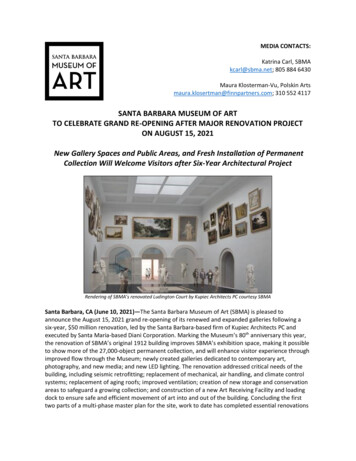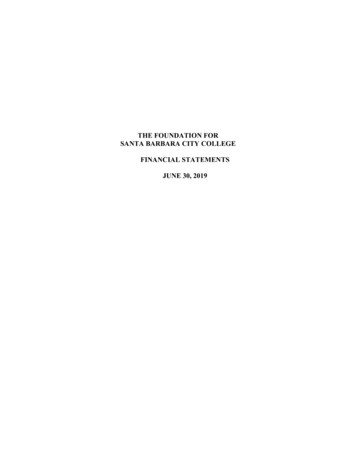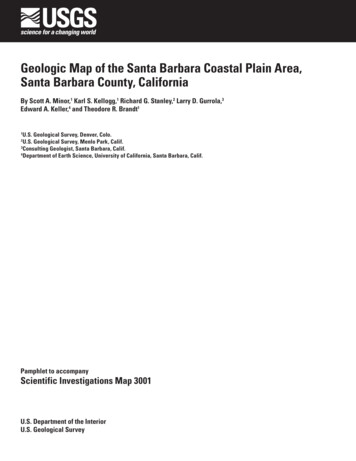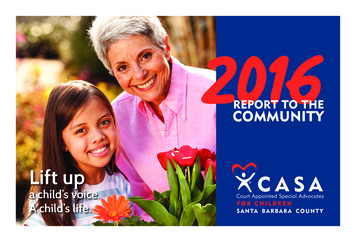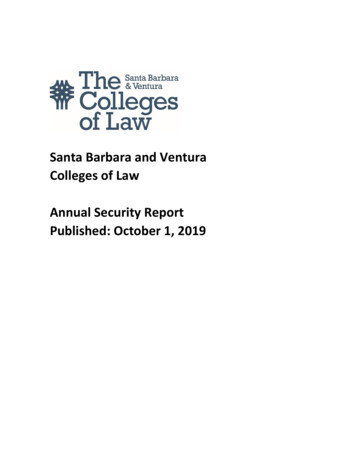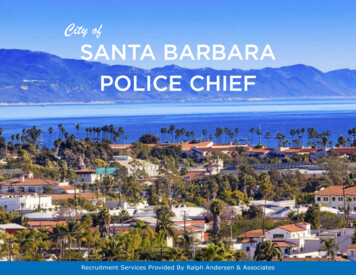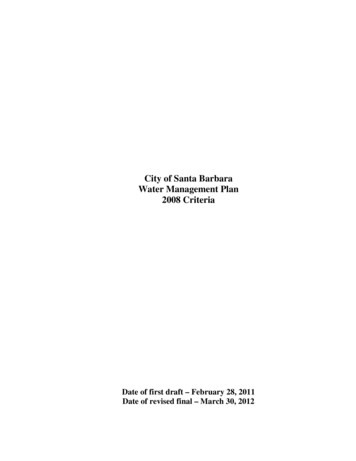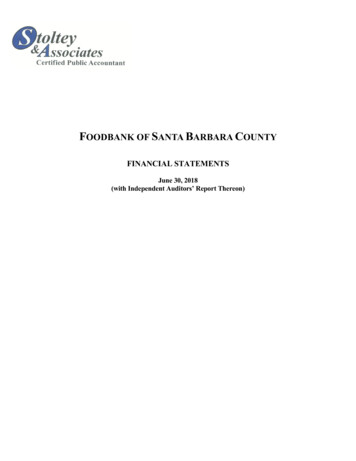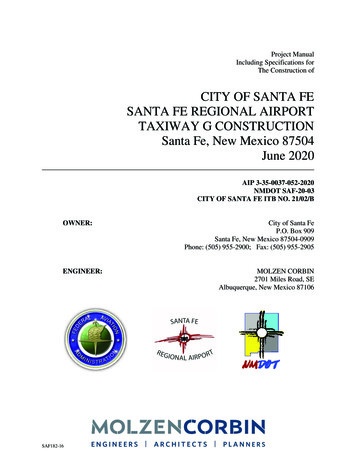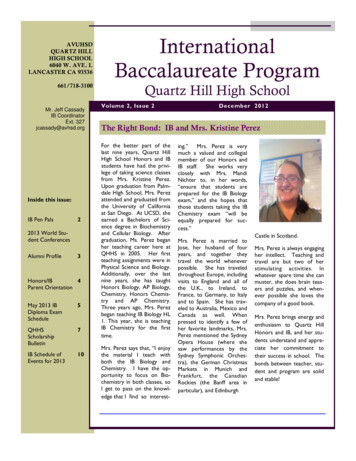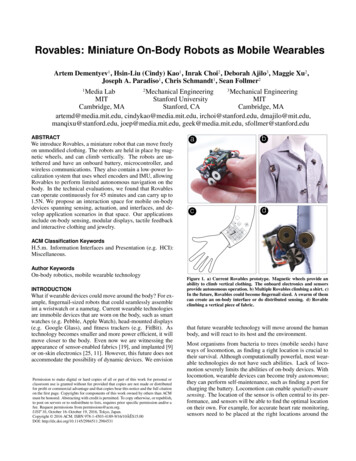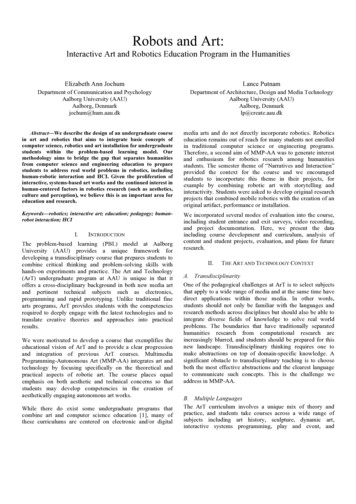
Transcription
Robots and Art:Interactive Art and Robotics Education Program in the HumanitiesElizabeth Ann JochumLance PutnamDepartment of Communication and PsychologyAalborg University (AAU)Aalborg, Denmarkjochum@hum.aau.dkDepartment of Architecture, Design and Media TechnologyAalborg University (AAU)Aalborg, Denmarklp@create.aau.dkAbstract—We describe the design of an undergraduate coursein art and robotics that aims to integrate basic concepts ofcomputer science, robotics and art installation for undergraduatestudents within the problem-based learning model. Ourmethodology aims to bridge the gap that separates humanitiesfrom computer science and engineering education to preparestudents to address real world problems in robotics, includinghuman-robotic interaction and HCI. Given the proliferation ofinteractive, systems-based art works and the continued interest inhuman-centered factors in robotics research (such as aesthetics,culture and perception), we believe this is an important area foreducation and research.media arts and do not directly incorporate robotics. Roboticseducation remains out of reach for many students not enrolledin traditional computer science or engineering programs.Therefore, a second aim of MMP-AA was to generate interestand enthusiasm for robotics research among humanitiesstudents. The semester theme of “Narratives and Interaction”provided the context for the course and we encouragedstudents to incorportate this theme in their projects, forexample by combining robotic art with storytelling andinteractivity. Students were asked to develop original researchprojects that combined mobile robotics with the creation of anoriginal artifact, performance or installation.Keywords—robotics; interactive art; education; pedagogy; humanrobot interaction; HCIWe incorporated several modes of evaluation into the course,including student entrance and exit surveys, video recording,and project documentation. Here, we present the dataincluding course development and curriculum, analysis ofcontent and student projects, evaluation, and plans for futureresearch.I.INTRODUCTIONThe problem-based learning (PBL) model at AalborgUniversity (AAU) provides a unique framework fordeveloping a transdisciplinary course that prepares students tocombine critical thinking and problem-solving skills withhands-on experiments and practice. The Art and Technology(ArT) undergraduate program at AAU is unique in that itoffers a cross-disciplinary background in both new media artand pertinent technical subjects such as electronics,programming and rapid prototyping. Unlike traditional finearts programs, ArT provides students with the competenciesrequired to deeply engage with the latest technologies and totranslate creative theories and approaches into practicalresults.We were motivated to develop a course that exemplifies theeducational vision of ArT and to provide a clear progressionand integration of previous ArT courses. MultimediaProgramming-Autonomous Art (MMP-AA) integrates art andtechnology by focusing specifically on the theoretical andpractical aspects of robotic art. The course places equalemphasis on both aesthetic and technical concerns so thatstudents may develop competencies in the creation ofaesthetically engaging autonomous art works.While there do exist some undergraduate programs thatcombine art and computer science education [1], many ofthese curriculums are centered on electronic and/or digitalII.THE ART AND TECHNOLOGY CONTEXTA. TransdisciplinarityOne of the pedagogical challenges at ArT is to select subjectsthat apply to a wide range of media and at the same time havedirect applications within those media. In other words,students should not only be familiar with the languages andresearch methods across disciplines but should also be able tointegrate diverse fields of knowledge to solve real worldproblems. The boundaries that have traditionally separatedhumanities research from computational research areincreasingly blurred, and students should be prepared for thisnew landscape. Transdisciplinary thinking requires one tomake abstractions on top of domain-specific knowledge. Asignificant obstacle to transdisciplinary teaching is to chooseboth the most effective abstractions and the clearest languageto communicate such concepts. This is the challenge weaddress in MMP-AA.B. Multiple LanguagesThe ArT curriculum involves a unique mix of theory andpractice, and students take courses across a wide range ofsubjects including art history, sculpture, dynamic art,interactive systems programming, play and event, and
entrepreneurship. While the program offers a wide range ofcourses across topics, few courses formally combine aesthetictheory and practice with programming and technology. Thelanguages of art and programming do not readily translateacross disciplines, and it is usually left to the students tocombine these two fields in their individual projects. Thecourse theme of “Languages of Motion” was an effort to bringcomputational motion and aesthetic motion into closeralignment. Furthermore, many of the technologies taught inArT involve software programs for screen-based media. Byfocusing on robotic art, we hoped to expand the students’awareness to include physics-based scenarios, encouragingstudents to experiment with new approaches to automatedmotion such as choreography.C. DemographicsThirteen students enrolled in MMP-AA. There were five malestudents and eight female students, ranging in age from 22-29years old. All of the students were third year (fifth semester)ArT bachelor students, and had varying levels of programmingexperience outside of the ArT curriculum. Most students hadbasic programming skills including C , HTML/CSS, andJava. Prior to MMP-AA, students had completed courses inbasic electronics, materials (including structure andcomposition), and digital representations (including lasercutting and 3D printing). One student had some priorexperience working with Lego Mindstorms, but beyond thatnone of the students had previous experience working withrobots. Most of the students had seen some robotic art works,but their familiarity with historical and contemporary roboticart and robotics research was limited.III.PEDADOGICAL APPROACHThis section outlines our pedagogical approach, including theteaching formats, curriculum and learning objectives.A. Co-TeachingOur teaching is based on a collaborative model whereteaching, assignments and evaluations are developed andimplemented collaboratively at the faculty level. Ourappointments are at the Faculty of Humanities and the Facultyof Engineering and Science respectively, which furtherstrengthens the transdisciplinary foundation of the course anddemonstrates to the students ways to foster fruitfulcollaboration between humanities, computer science andengineering. We also decided that both professors should bepresent at all lessons in order to facilitate communicationacross disciplines.B. Lecture/Workshop FormatWe deliberately structured the course to balance the timebetween lectures and hands-on workshops as well as aestheticand technical considerations. The course consisted of eightlessons in total with each lesson lasting two hours. Lessonstypically followed the structure of a lecture on a specific topicfollowed immediately by a hands-on learning exercise ordiscussion. Wherever possible, individual lessons incorporatedboth technical and aesthetic topics.C. CurriculumThe overall curriculum aimed to teach students how to design,program and execute a computer-controlled work of art basedon computational models and theories in robotic art. Thelesson topics were Origin and development of robotic artRobot communicationsLanguages of motion I (periodic motion and randomwalks)Languages of motion II (kinesics, flocking, emergentbehavior)Markov chains and “Acting for Robots"Workshop on designing and constructing robotbodies and mechanisms with a visiting robot artistThe remaining two lessons were in-class presentations of themidterms and final projects, where the students were asked topresent their functioning prototypes and answer questionsabout their projects.Students were provided with robots to experiment with (themobile Arduino robot and Sphero mobile robot), but were alsogiven the opportunity to develop their own design or roboticprototypes. As the course is an upper-level undergraduatecourse, a prerequisite for enrollment is imperative and objectoriented programming (e.g., C or Java).D. Project-Based AssignmentsFollowing the AAU PBL model, we used project-basedassignments to encourage students to engage in open-ended,play-based experimentation and inquiry. We deliberatelyrefrained from placing too many constraints on the midtermand final projects, but rather encouraged students to be guidedby their own curiosity given the constraints of the relativelysimple robotic platforms. Our hope was that this would resultin works that were relevant to the students’ experience, skilllevel and general artistic interest.A necessary component for developing interactive, robotic artworks is to investigate, anticipate or understand humanresponse and reactions to the exhibited art works [2]. Thesetopics are relevant to the study of robot design and HRIresearch [3]. In their projects, students were expected to applytheoretical foundations from art and performance and toexplore the aesthetic potential of motions. From this we canlearn how to approach concepts such as autonomy andinteractivity on an experiential and aesthetic level.There were two assignments in the course: 1) a midtermsketch/study and one-page written summary outlining theresearch project and 2) the completion of a group-basedmini-project incorporating computer-controlled robotics. Themini-project was presented in class, and the functioningprototype was accompanied by a written report and oralpresentation summarizing the project, method, approach andconclusions.
Students were allowed to form their own project groups andwe made no effort to balance the groups in terms of skill sets,e.g., programming. Rather, we preferred the students formgroups based on shared interest in a topic or specific roboticplatform. We speculate that this approach worked wellbecause of multiple factors: all students had basicprogramming skills, the incorporation of group-based classexercises, and students were from the same study program(ArT). If the student population was more diverse, it may havebeen necessary to structure the group formation more.However, the group-based class exercises may have theadditional benefit of getting students acquainted with oneanother.IV.advantage of the Arduino Robot over the Sphero is thatadditional sensors, such as a video camera, can be easilyattached to the robot. The Sphero, on the other hand, can beused on a wider variety of terrains, including water, and maybe easier to use as an actuator.IMPLEMENTATIONIn this section, we present a detailed description of howcertain aspects of the course were implemented. We discussthe selected teaching platforms, programming languages, andalgorithms and describe the robot artist workshop and studentprojects.A. Theme: Languages of MotionThe underlying theme of MMP-AA was “Languages ofMotion.” Our goal was to introduce elementary algorithms ofmotion and how those motions, individually or combined intochoreography, can create an aesthetic response in the viewer.One goal of robotic or interactive systems-based art is toevoke emotional responses through planned motions executedby otherwise inanimate objects. Other media such as computeranimation and sound have their own specific languages ofmotion, and we believe there are general principles withinlanguages that can be applied directly to robotics. Forexample, random paths are useful for exploration and formasking artificial movements and periodic functions can becomposed to synthesize complex, structured patterns.Understanding the link between the languages of motion andaesthetic and cognitive responses may open up new ways ofthinking about design and interactivity for robotics research[4].B. PlatformsAs the intention of the course was to focus on robotcommunications and languages of motion, we wanted to useready-made mobile robots that supported open, standardprotocols. We ruled out use of drones and other 3D-navigablerobots early on as we felt these would present too manytechnical challenges as well as safety issues for anintroductory course. The robot platforms chosen were theOrbotix Sphero 2.0 [5] (Figure 1) and Arduino Robot [6](Figure 2). The Sphero is a Bluetooth-controlled, hermeticallysealed ball that can be commanded to move and turn relativeto an initial reference frame. It also has a controllable coloredlight and can stream numerous sensor data back to the clientincluding its position, accelerometer, gyro and IMU readings.The Arduino Robot is essentially a programmable twowheeled cart. It also provides buttons and a dial for user inputand a display screen and speaker for feedback. A majorFigure 1. The Orbotix Sphero 2.0 remote-controlled mobilerobot. Shown are its outer appearance (left) and innerworkings (right). (Images from http://www.gosphero.com.)Figure 2. Illustration of the Arduino Robot: a programmabletwo-wheeled cart robot.C. ProgrammingIt was important to use the same programming language forboth robot platforms to maximize the possibility of code reuse.We selected C as it is used by the Arduino platform andmuch of the robotics community. For the Sphero, we used theAlloSystem multimedia toolkit [7] and custom-madeBluetooth client and Sphero packet generating and parsingclasses. We considered using the Robot Operating System(ROS) [8] but at the moment only Linux/Ubuntu is officiallysupported and most of our students use either Windows orOS X.The algorithms we selected were meant to teach the studentsabout elementary types of motions and how to combine thosemotions. For the elementary motions, we chose circularmotion, random walks, and flocking [9] as the basis forperiodic, random, and force-based motions, respectively. Tocombine motions two main principles were introduced: motion
superposition, i.e. weighted vector summation of elementarymotions, and time-based sequencing. Sequencing, in turn, wasdivided into two main approaches: linear and random. Linearsequencing consisted of a series of control commandsseparated by delta times while random sequencing wasimplemented via Markov chains with fixed delta timesbetween state transitions.In-class assignments were conducted using the Sphero andgenerally followed a progression from simple to morecomplex tasks. For example, in one lesson, the first task wasto change the color of the Sphero's light. This progressed tomoving the Sphero in a line and then stopping, and then ontocircular and random motions. The last exercise was tosimultaneously control the motion and color of the Spheroaccording to some pattern.D. Workshop with Guest ArtistOne special feature of the course was a one-day workshoptaught by a visiting robot artist. The artist also gave acorresponding lecture on his own art works and designmethodology. In the workshop, students constructed simplemechanisms (gears, belts, and pulleys) with flexible and cheapmaterials such as cardboard boxes, straws and rubber bands. Inthe second part of the workshop students were taught how tocombine the mechanisms with Arduino controllers.Unfortunately, we did not allow enough time for the studentsto implement more advanced mechanisms, but each studentsucceeded at designing and constructing a functioningprototype. After working with rigid bodies with limiteddegrees of freedom and movement primitives (i.e., the Spheroand Arduino robots), the students enjoyed the chance to workwith flexible materials and to design their own robots.Unfortunately, the workshop came too late in the semester forstudents to incorporate this knowledge into their projects. Inhindsight, we believe the students would have benefited fromthe workshop earlier in the semester before they commencedwork on their final projects. This would have introduced thepossibility of building their own robots or combining theArduino or Sphero with custom-built robots or parts.E. Project DescriptionsThirteen students worked in five groups. The projects reflecteda wide range of topics, some more scientific and others moreartistic in their approach and methodology.1.2.Color/Gesture Mapping. This project aimed to mapcolor changes to the Sphero based on human-robotinteraction, using the robot’s orientation and alteredmotion trajectories (human input) to control the colorof the aphic structures from human dancers togenerate motion trajectories for three Sphero“dancers” to create dramatic tension and evoke anemotional response in the viewers.3.4.5.FlirtyBot. Using an Arduino Robot, this project builta social robot with a distinct personality, using simpleinteractions such as dialogue, sound, and simplemovement patterns in response to input from thehuman user.Mind-controlled Sphero. This project combined theSphero platform with the Emotiv EPOC biopotentialneuron headset [10] to simulate telekinesis. Thecustom software (authored by the students) enabledusers to control the motion of the Sphero in real timeusing only facial expressions.“Kiwi” Interactive Narrative. This roboticperformance combined preprogrammed and teleoperated Spheros with live shadow puppetry, amusical score and narration based on the Kiwi bird, aflightless bird from New Zealand. The studentsdeveloped a storyboard and applied principles ofnarratives and interaction to generate an originalperformance (Figure 3).Figure 3. Storyboard of the “Kiwi” Interactive Narrativestudent project. This was a live performance that combinedpreprogrammed and tele-operated Spheros with live shadowpuppetry, a musical score, and narration based on the flightlessbird from New Zealand.V.ANALYSIS AND REFLECTIONSThis section presents analysis and reflections of the coursebased on our observations and experiences in the classroom,evaluation of student projects, and student feedback.A. Entrance and Exit SurveysAt the beginning of the course, students were asked tocomplete an entrance survey that included questions aboutprior programming experience and experience with robots androbotic art, as well as their expectations for the course. All
thirteen students completed the intake survey. On the last daystudents were asked to complete an exit survey, whichincluded questions on the course content, format, projects andchallenges they faced. Eight students completed the exitsurvey.Based on the entrance surveys, many students were excitedabout the possibility of moving from screen-based media tophysical systems (“reaching beyond the screen”), and somethought that working with robots would deepen theirunderstanding and knowledge of programming. Nearly all ofthe students expressed enthusiasm about the “hands-on” natureof the course, and were eager to apply their skills to moreadvanced, interactive art works that involved human-robotinteraction.The exit surveys show that students’ initial expectations werelargely met, and the students generally agreed that the coursestruck a good balance between theory and practice. Thestudents appreciated the flexibility to develop their ownprojects as well as the opportunity to apply theory to practicein the in-class workshops and assignments. Studentsresponded positively to the challenge of working in thephysical world, including discovering the limits andchallenges of working in physics-based scenarios.Working with physical systems challenged the students in newand unexpected ways:“Robots sometimes react to the physical world inunpredictable ways. They might also bepreprogrammed with a behavior that clashes withsomething we want to make them do.”“A lot of the stuff we have been programming havehad screen-based outputs. It was nice and quiteinteresting to be able to move into the physical world,and discover the limits thereof. Suddenly we had todeal with a whole new set of issues and problemsalong the anbequiteMany of the groups made an effort to apply theories ofnarrative and interaction to their projects:“In conclusion of the design process, many lessonshave been learnt, both practical and aesthetic increating robotic based art. The group has discoveredthe power of motion in narrative storytelling and howrobots can seem more lifelike and organic with focuson movement rather than on form. [ ] Thismovement can be implemented like an actor in atheatrical performance.”B. PlatformsOut of the five student projects, four projects involved use ofthe Sphero and only one project used the Arduino Robot. Oneexplanation for this preference may be because the Sphero wasused as the primary teaching platform, but also possibly due toits simplistic, yet open-ended nature.One of the problems we encountered with the Sphero is that itis difficult to get it to move accurately along a predefinedtrajectory over time. This stems partially from its lack ofability to report its absolute position and orientation. Oursolution was to run a calibration program before eachperformance and align the Spheros through visual inspection.Other factors such as slipping, changes in momentum, ordropped control packets can also introduce errors in themotion trajectory and cannot be prevented through calibration.A workaround to these problems, which we did not test, maybe to use some form of feedback control.C. AlgorithmsOverall, the students responded well to the algorithms thatwere taught. Most notably, several students expressed a deepinterest in the theory of Markov chains and requested a morein-depth study of them.The application of the presented algorithms to the projectwork varied. We found that students tended to pick onealgorithm and explore its possibilities rather than combiningmultiple algorithms. For example, one project exclusivelyused circular motions, another used primarily random walks,and a third utilized a Markov chain consisting of move/turncommands. A possible explanation for this, supported by theproject reports, is that the students encountered unexpectedtechnical challenges along way and simply did not have timeto progress beyond the basic algorithms. None of the projectsmade use of flocking which could be due either to the smallnumber of project groups or the demand of the algorithm formore advanced control of multiple robots.D. Co-teachingStudents were generally enthusiastic about the co-teachingmodel, and suggested that it was helpful to have bothprofessors on-hand to answer questions and to maintain thebalance between artistic and technical discourses. Personally,we feel that our distinct areas of expertise werecomplementary and that our mutual interest and engagementin the topic of autonomous art was a good model for thestudents.VI.FUTURE WORKOverall the students and professors were satisfied with thecourse, and many students expressed interest in continuingwork on their projects. Given their interest and the strongartistic and technical merit of the projects, we plan to developa second course that builds on this framework. Our objectiveis to develop the skills and competencies the students acquiredin MMP-AA by expanding on the knowledge and practice ofrobotic art.
ReferencesIn the next course, we will introduce basic feedback controlusing video or other sensor data to address some of theproblems with obtaining precise trajectories. We plan tointroduce new algorithms that can be used to generate motionsuch as gradient fields, cellular automata, and chaotic or othernon-linear equations. We are also interested in conducting ahands-on workshop in 3D-printed bodies and mechanisms thatwill build on the students' previous coursework in rapidprototyping. Overall, we hope that students will be able torefine their previous projects and at the same time experimentwith designing their own robots and news forms of expressivemotion.ACKNOWLEDGMENTWe thank Mikael Vetner, Falk Heinrich, and Ståle Stenslie fortheir commitment to this course and to research-basedteaching. We thank the members of the RELATE researchgroup for their early advice and support of this project.[1]H.J. Kim et al. “Artbotics: community-based collaborative art andtechnology education,” ACM SIGGRAPH 2007 educators program.ACM, New York, NY, USA, 2007.[2] O. Bown et al., “The Machine as Autnomous Performer,” in InteractiveExpereince in the Digital Age. L Candy and S. Ferguson, Eds. Springer,2014, pp. 75-90.[3] K. Dautenhahn, “Methodology & Themes of Human-Robot Interaction:A Growing Research Field,” International Journal of Advanced RoboticSystems, vol. 4, no. 1, pp. 103-108, 2007.[4] G. Hoffman and W. Ju. “Designing Robots with Movement in Mind,”Journal of Human-Robot Interaction, vol 3, no. 1, pp. 89-122, 2007.[5] Go Sphero, (2014). [Online]Available: http://www.gosphero.com/sphero-2-0/[6] Arduino Robot, (2014). [Online]Available: http:// http://arduino.cc/en/Main/Robot[7] Git Hub, Inc. (2014). AlloSphere-Research-Group/AlloSystem. [Online]Available: ystem[8] M. Quigley et al. "ROS: an open-source Robot Operating System,"IRCA Workshop on Open Source Software, vol. 3, no. 3.2, 2009.[9] C. W. Reynolds. “Flocks, herds, and schools: A distributed behavioralmodel,” Computer Graphics, vol. 21, no. 4, pp. 25-34, 1987.[10] Emotiv, (2014). Emotiv EPOC/EPOC [Online] Available:https://emotiv.com/epoc.php
Department of Communication and Psychology Aalborg University (AAU) Aalborg, Denmark jochum@hum.aau.dk Lance Putnam Department of Architecture, Design and Media Technology Aalborg University (AAU) Aalborg, Denmark lp@create.aau.dk Abstract—We describe the design of an undergraduate course
